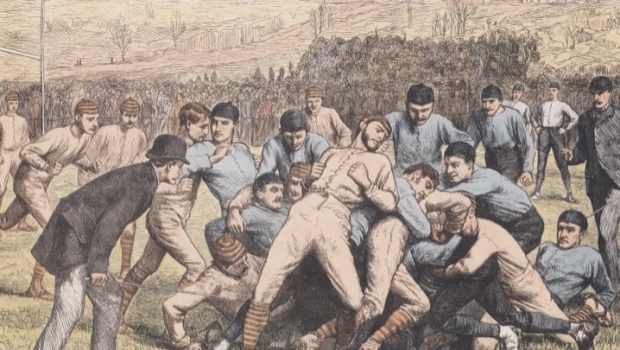
Baseball, Kickball, Stoopball, Stickball…
Story by: Melissa Abernathy
Photos Courtesy of Historical Museum
Hoboken at Play, from the Fields of Elysian to the City Streets
Before “go out and play” meant “set up an elaborate schedule of play dates” or membership in a sports league, Hoboken children and young adults pretty much had to invent their own recreation. Oral histories in the Hoboken Historical Museum’s archives contain many recollections of games played here and throughout the New York urban area with names like Johnny-on-the-Pony, Ring-a-Lario, stoopball and box ball, and the king of improvised urban sports, stickball.
A Hoboken kid’s playground, usually supervised from an upper window by an older relative, was the street or sidewalk, and their teammates were kids from their own block. The rules of the games could vary from neighborhood to neighborhood – negotiating the rules was half the fun. Indeed, that spirit of invention dates all the way back to Hoboken’s earliest days as a recreational venue, in the mid- 1840s, when Alexander Cartwright’s Knickerbocker Base Ball Club tinkered with and perfected the rules of baseball on Hoboken’s renowned Elysian Fields.
In fact, recreation was Hoboken’s main “industry” before its incorporation in 1855. In the 1850 census, the city’s population was less than 3,000, and the Stevens family developed the River Walk and a vast playing field at the north end of the waterfront to attract people to visit and put down roots.
Their strategy worked, evidently, as the city’s population more than tripled over the next decade to 9,662, according to an excellent book on immigration history by Dr. Christina Ziegler-McPherson, Immigrants in Hoboken, One- Way Ticket, 1845-1985. The historian is the guest curator for the Museum’s next exhibit, opening August 3, called “Destination Hoboken: The Immigrant’s Story 1892-1924,” which will explore Hoboken’s rapid expansion and its role in the peak years of U.S. immigration.
From the mid-1800s to the turn of the century, Hoboken’s Elysian Fields and St. George’s Cricket Grounds hosted many famous amateur sporting events, written up in The New York Times and popular illustrated magazines. A search of the Hoboken Historical Museum’s online collections [www.hobokenmuseum.org/research/collections] turns up engravings of international cricket matches between Canada and the United States in 1858 (right), and intercollegiate football games between Columbia and Harvard in 1877, and Yale vs. Princeton in 1879 (page 24).
As the Hoboken landscape became more densely urbanized, the city’s youth were forced to adapt their games to the streetscape. By 1910, Hoboken’s population peaked at 70,324, and remained above 50,000 through 1950. Imagine today’s population sharing the same square mile, but without any waterfront parks or walkways, and factories where many of today’s condominiums are!
Many people who grew up here in the 1950s and 1960s remember the street games well. Kickball, kick-the-can, Ring-a-Lario, and Johnny-on-the-Pony were folk traditions handed down from generation to generation. Girls played jump rope and hopscotch. “In the daytime, as girls, we would stay together and play games or go to the park. We’d also play jump rope and hopscotch. There was a shoemaker nearby and he would give us old heels to use for our games,” recalls Marie Radigan in a forthcoming Hoboken Historical Museum book, I Was Born in Hoboken, by Bill Miller, about growing up in Hoboken in the mid-19th century. Kids creatively incorporated the urban landscape into their games. Some games required only a ball with some bounce—ideally, a “spaldeen” by the Spalding sporting goods company—and a solid wall or stairway.
Box ball, for example, turned a pair of sidewalk squares into a kind of ping-pong court, where open palms served as paddles. Manhole covers or the four corners of an intersection could serve as bases for stickball games, where a broomstick with tape wrapped around the end typically served as a bat. In I Was Born in Hoboken, Ron Buzzanca recalls, “We always played stick ball on the side of Brandt School. We’d dodge cars, accidentally hit windows, and follow trucks. But we’d always wait for baby carriages to cross. We never wanted to hit a baby. ”
Not every youthful activity was as hazardous to windows as stickball in the 1950s. The Parks Department held summer competitions for kids in art, sewing, chess, and checkers. Playing marbles was a popular activity. Of course, summer days in the city without air conditioning could get very hot. Cooling off during the day might mean jumping into the cold water streaming out of open fire hydrants, or enjoying wading pools and cold showers in parks.
These are just a few examples of the oral histories and vintage photographs that the Hoboken Historical Museum has added over the years to its growing collections of artifacts, photos and documents. Much of these are easily accessible on our website. If you have a story or artifact to donate, drop an email to collections@hobokenmuseum.org. ••

 Previous Article
Previous Article Next Article
Next Article OH, THE HUMANITY: Blimpie Crashes Out of Hoboken
OH, THE HUMANITY: Blimpie Crashes Out of Hoboken  DIVERSE CITY: Jersey City Named as the Most Diverse Place in America
DIVERSE CITY: Jersey City Named as the Most Diverse Place in America  September 11, 2001 — the Hoboken Community Remembers
September 11, 2001 — the Hoboken Community Remembers  READ ALL ABOUT IT: The Hoboken Public Library Celebrates 125 Years of Greatness and Community Leadership
READ ALL ABOUT IT: The Hoboken Public Library Celebrates 125 Years of Greatness and Community Leadership  FRIDAYS ARE FOR FRANK: “I Wish You Love” (feat. the Count Basie Orchestra)
FRIDAYS ARE FOR FRANK: “I Wish You Love” (feat. the Count Basie Orchestra)  FRIDAYS ARE FOR FRANK: “Nancy”
FRIDAYS ARE FOR FRANK: “Nancy”  FRIDAYS ARE FOR FRANK: “I’m Gonna Sit Right Down And Write Myself A Letter” (USPS Edition)
FRIDAYS ARE FOR FRANK: “I’m Gonna Sit Right Down And Write Myself A Letter” (USPS Edition)  FRIDAYS ARE FOR FRANK: “Dark Eyes” (feat. Jimmy Durante)—Sinatra Sings in Russian
FRIDAYS ARE FOR FRANK: “Dark Eyes” (feat. Jimmy Durante)—Sinatra Sings in Russian